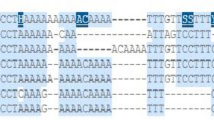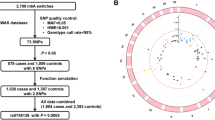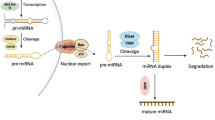Abstract
MicroRNAs (miRNAs) play an important role in regulating gene expression at the post-transcriptional level and are involved in numerous physiological processes. Accumulating evidence suggests that single-nucleotide polymorphisms (SNPs) in human miRNA genes may affect miRNA biogenesis pathway and influence the susceptibility to several diseases such as cancer. The aim of the study was to investigated whether three common miRNA polymorphisms [miR-146a C>G (rs2910164), miR-149 T>C (rs2292832), and miR-196a2 T>C (rs11614913)] are associated with the susceptibility and prognosis of gastric cancer (GC) in the Greek population. The three mRNA SNPs were identified in a case–control study (163 patients; 480 controls) by polymerase chain reaction–restriction fragment length polymorphism (PCR–RFLP) analysis. We found that the risk for GC was significantly higher for the carriers of miR-149 rs2292832CC (p = 0.009) and miR-196a2 rs11614913CC (p < 0.0001) genotypes, as well as for the carriers of the rs2910164/rs2292832/rs11614913 CCC and GTC haplotype (p < 0.0001 and p = 0.03, respectively). The rs2910164/rs2292832/rs11614913 CTT and CCT haplotypes seems to have a protective role against GC (p = 0.002 and p = 0.001, respectively). Our data demonstrate that specific miRNA SNPs are associated with GC susceptibility in the Greek population.
Similar content being viewed by others
References
Noffsinger A, Waxman I (2007) Preinvasive neoplasia in the stomach: diagnosis and treatment. Clin Gastroenterol Hepatol 9:1018–1023
Ferlay J, Shin HR, Bray F, Forman D, Mathers C, Parkin DM (2010) Estimates of worldwide burden of cancer in 2008: GLOBOCAN 2008. Int J Cancer 127:2893–2917
Resende C, Ristimäki A, Machado JC (2010) Genetic and epigenetic alteration in gastric carcinogenesis. Helicobacter 15:34–39
Venkateshwari A, Krishnaveni D, Venugopal S, Shashikumar P, Vidyasagar A, Jyothy A (2011) Helicobacter pylori infection in relation to gastric cancer progression. Indian J Cancer 48:94–98
Kamangar F, Abnet CC, Hutchinson AA et al (2006) Polymorphisms in inflammation-related genes and risk of gastric cancer (Finland). Cancer Causes Control 17:117–125
Sugimoto M, Yamaoka Y, Furuta T (2010) Influence of interleukin polymorphisms on development of gastric cancer and peptic ulcer. World J Gastroenterol 16:1188–1200
Yuzhalin A (2011) The role of interleukin DNA polymorphisms in gastric cancer. Hum Immunol 72:1128–1136
Landi D, Gemignani F, Barale R, Landi S (2008) A catalog of polymorphisms falling in microRNA-binding regions of cancer genes. DNA Cell Biol 27:35–43
Zhou F, Zhu H, Luo D et al (2012) A functional polymorphism in Pre-miR-146a is associated with susceptibility to gastric cancer in a Chinese population. DNA Cell Biol 31:1290–1295
Carthew RW (2006) Gene regulation by microRNAs. Curr Opin Genet Dev 16:203–208
Ambros V (2003) MicroRNA pathways in flies and worms: growth, death, fat, stress, and timing. Cell 113:673–676
Xiao C, Rajewsky K (2009) MicroRNA control in the immune system: basic principles. Cell 136:26–36
Kim BH, Hong SW, Kim A, Choi SH, Yoon SO (2012) Prognostic implications for high expression of oncogenic microRNAs in advanced gastric carcinoma. J Surg Oncol 107:505
Chen W, Tang Z, Sun Y et al (2012) miRNA expression profile in primary gastric cancers and paired lymph node metastases indicates that miR-10a plays a role in metastasis from primary gastric cancer to lymph nodes. Exp Ther Med 3:351–356
Liu Z, Li G, Wei S et al (2010) Genetic variants in selected pre-microRNA genes and the risk of squamous cell carcinoma of the head and neck. Cancer 116:4753–4760
Hezova R, Kovarikova A, Bienertova-Vasku J et al (2012) Evaluation of SNPs in miR-196-a2, miR-27a and miR-146a as risk factors of colorectal cancer. World J Gastroenterol 18:2827–2831
Chu YH, Tzeng SL, Lin CW, Chien MH, Chen MK, Yang SF (2012) Impacts of microRNA gene polymorphisms on the susceptibility of environmental factors leading to carcinogenesis in oral cancer. PLoS ONE 7:e39777
Zeng Y, Sun QM, Liu NN, Dong GH, Chen J, Yang L (2010) Correlation between pre-miR-146a C/G polymorphism and gastric cancer risk in Chinese population. World J Gastroenterol 16:3578–3583
Okubo M, Tahara T, Shibata T, Yamashita H, Nakamura M, Yoshioka D (2010) Association between common genetic variants in pre-microRNAs and gastric cancer risk in Japanese population. Helicobacter 15:524–531
Peng S, Kuang Z, Sheng C, Zhang Y, Xu H, Cheng Q (2010) Association of microRNA-196a-2 gene polymorphism with gastric cancer risk in a Chinese population. Dig Dis Sci 5:2288–2293
Ahn DH, Rah H, Choi YK et al (2012) Association of the miR-146a C>G, miR-149 T>C, miR-196a2 T>C, and miR-499 A>G polymorphisms with gastric cancer risk and survival in the Korean population. Mol Carcinog 52:E39
Esquela-Kerscher A, Slack FJ (2006) Oncomirs—microRNAs with a role in cancer. Nat Rev Cancer 6:259–269
Croce CM (2009) Causes and consequences of microRNA dysregulation in cancer. Nat Rev Genet 10:704–714
Taganov KD, Boldin MP, Chang KJ, Baltimore D (2006) NF-kappaB-dependent induction of microRNA miR-146, an inhibitor targeted to signaling proteins of innate immune responses. Proc Natl Acad Sci USA 103:12481–12486
Cameron JE, Yin Q, Fewell C, Lacey M, McBride J, Wang X (2008) Epstein-Barr virus latent membrane protein 1 induces cellular MicroRNA miR-146a, a modulator of lymphocyte signaling pathways. J Virol 82:1946–1958
Karin M (2009) NF-kappaB as a critical link between inflammation and cancer. Cold Spring Harb Perspect Biol 1:a000141
Naugler WE, Karin M (2008) NF-kappaB and cancer-identifying targets and mechanisms. Curr Opin Genet Dev 18:19–26
Nahid MA, Pauley KM, Satoh M, Chan EK (2009) miR-146a is critical for endotoxin-induced tolerance: IMPLICATION IN INNATE IMMUNITY. J Biol Chem 284:34590–34599
Jazdzewski K, Murray EL, Franssila K, Jarzab B, Schoenberg DR, de la Chapelle A (2008) Common SNP in pre-miR-146a decreases mature miR expression and predisposes to papillary thyroid carcinoma. Proc Natl Acad Sci USA 105:7269–7274
Lin SL, Chiang A, Chang D, Ying SY (2008) Loss of mir-146a function in hormone-refractory prostate cancer. RNA 14:417–424
Tchernitsa O, Kasajima A, Schäfer R et al (2010) Systematic evaluation of the miRNA-ome and its downstream effects on mRNA expression identifies gastric cancer progression. J Pathol 222:310–319
Hou Z, Xie L, Yu L, Qian X, Liu B (2012) MicroRNA-146a is down-regulated in gastric cancer and regulates cell proliferation and apoptosis. Med Oncol 29:886–892
Kogo R, Mimori K, Tanaka F, Komune S, Mori M (2011) Clinical significance of miR-146a in gastric cancer cases. Clin Cancer Res 17:4277–4284
Shen J, Ambrosone CB, DiCioccio RA, Odunsi K, Lele SB, Zhao H (2008) A functional polymorphism in the miR-146a gene and age of familial breast/ovarian cancer diagnosis. Carcinogenesis 29:1963–1966
Yue C, Wang M, Ding B et al (2011) Polymorphism of the pre-miR-146a is associated with risk of cervical cancer in a Chinese population. Gynecol Oncol 122:33–37
Wang J, Bi J, Liu X, Li K, Di J, Wang B (2012) Has-miR-146a polymorphism (rs2910164) and cancer risk: a meta-analysis of 19 case–control studies. Mol Biol Rep 39:4571–4579
Lin T, Ding Z, Li N et al (2011) 2-Tellurium-bridged β-cyclodextrin, a thioredoxin reductase inhibitor, sensitizes human breast cancer cells to TRAIL-induced apoptosis through DR5 induction and NF-κB suppression. Carcinogenesis 32:154–167
Lin RJ, Lin YC, Yu AL (2010) miR-149* induces apoptosis by inhibiting Akt1 and E2F1 in human cancer cells. Mol Carcinog 49:719–727
Zhang J, Liu YF, Gan Y (2012) Lack of association between miR-149 C>T polymorphism and cancer susceptibility: a meta-analysis based on 4,677 cases and 4,830 controls. Mol Biol Rep 39:8749–8753
Lagos-Quintana M, Rauhut R, Meyer J, Borkhardt A, Tuschl T (2003) New microRNAs from mouse and human. RNA 9:175–179
Hu Z, Chen J, Tian T et al (2008) Genetic variants of miRNA sequences and non-small cell lung cancer survival. J Clin Invest 118:2600–2608
Tian T, Shu Y, Chen J et al (2009) A functional genetic variant in microRNA-196a2 is associated with increased susceptibility of lung cancer in Chinese. Cancer Epidemiol Biomarkers Prev 18:1183–1187
Ye Y, Wang KK, Gu J et al (2008) Genetic variations in microRNA-related genes are novel susceptibility loci for esophageal cancer risk. Cancer Prev Res (Phila) 1:460–469
Qi P, Dou TH, Geng L et al (2010) Association of a variant in MIR 196A2 with susceptibility to hepatocellular carcinoma in male Chinese patients with chronic hepatitis B virus infection. Hum Immunol 71:621–626
Christensen BC, Avissar-Whiting M, Ouellet LG et al (2010) Mature microRNA sequence polymorphism in MIR196A2 is associated with risk and prognosis of head and neck cancer. Clin Cancer Res 16:3713–3720
Guo J, Jin M, Zhang M, Chen K (2012) A genetic variant in miR-196a2 increased digestive system cancer risks: a meta-analysis of 15 case–control studies. PLoS ONE 7:e30585
Author information
Authors and Affiliations
Corresponding author
Rights and permissions
About this article
Cite this article
Dikeakos, P., Theodoropoulos, G., Rizos, S. et al. Association of the miR-146aC>G, miR-149T>C, and miR-196a2T>C polymorphisms with gastric cancer risk and survival in the Greek population. Mol Biol Rep 41, 1075–1080 (2014). https://doi.org/10.1007/s11033-013-2953-0
Received:
Accepted:
Published:
Issue Date:
DOI: https://doi.org/10.1007/s11033-013-2953-0




